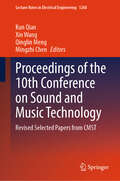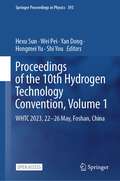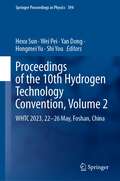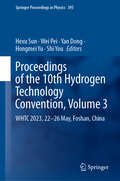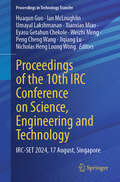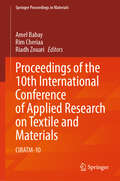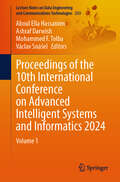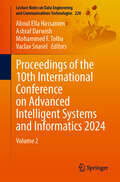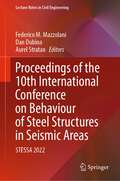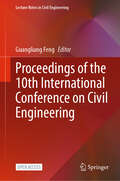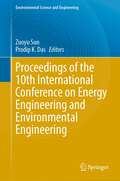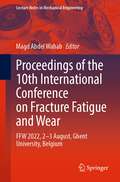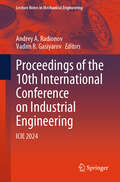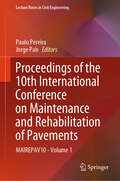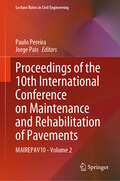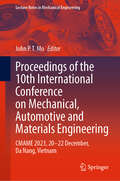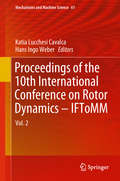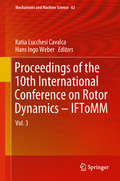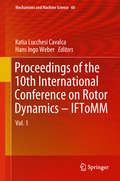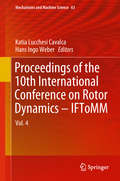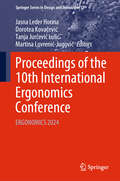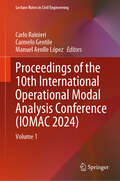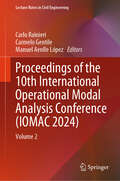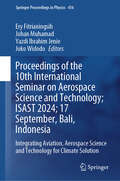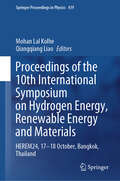- Table View
- List View
Proceedings of the 10th Conference on Sound and Music Technology: Revised Selected Papers from CMST (Lecture Notes in Electrical Engineering #1268)
by Xin Wang Kun Qian Qinglin Meng Mingzhi ChenThe book presents selected papers at the 10th Conference on Sound and Music Technology (CSMT) held in June 2023, China. CSMT is a multidisciplinary conference focusing on audio processing and understanding with bias on music and acoustic signals. The primary aim of the conference is to promote the collaboration between art society and technical society in China. In this book, the paper included covers a wide range topic from speech, signal processing, music understanding, machine learning, and signal processing for advanced medical diagnosis and treatment applications, which demonstrates the target of CSMT merging arts and science research together. Its content caters to scholars, researchers, engineers, artists, and education practitioners not only from academia but also industry, who are interested in audio/acoustics analysis signal processing, music, sound, and artificial intelligence (AI).
Proceedings of the 10th Hydrogen Technology Convention, Volume 1: WHTC 2023, 22-26 May, Foshan, China (Springer Proceedings in Physics #393)
by Yan Dong Hexu Sun Wei Pei Hongmei Yu Shi YouThis open access book highlights the latest advances in fundamental research, technologies and applications of hydrogen energy and fuel cells. In recent years, energy conversion between electricity and hydrogen energy has attracted increasing attention as a way to adjust the load of the grid. This book discusses and exchanges cutting-edge findings and technological developments in fields such as new proton exchange membrane electrolyzers, new electrode materials and catalysts, renewable energy, off-grid/grid-connected water electrolysis for hydrogen production, key materials and components of fuel cells, high-temperature solid oxide water electrolysis, energy storage technologies and research, CO2 hydrogenation to methanol, nitrogen to ammonia and other applications with industrial potential.The main topics of the proceedings include:1) Policies and strategies for hydrogen energy and fuel cells;2) Advanced proton exchange membranes, electrodes and catalyst materials for water electrolysis;3) Advanced hydrogen compression, storage, transportation and distribution technologies;4) Safety and related standards;5) Manufacture and R&D of key materials and components of fuel cells and stack systems.
Proceedings of the 10th Hydrogen Technology Convention, Volume 2: WHTC 2023, 22–26 May, Foshan, China (Springer Proceedings in Physics #394)
by Yan Dong Hexu Sun Wei Pei Hongmei Yu Shi YouThis book highlights the latest advances in fundamental research, technologies and applications of hydrogen energy and fuel cells. In recent years, energy conversion between electricity and hydrogen energy has attracted increasing attention as a way to adjust the load of the grid. This book discusses and exchanges cutting-edge findings and technological developments in fields such as new proton exchange membrane electrolyzers, new electrode materials and catalysts, renewable energy, off-grid/grid-connected water electrolysis for hydrogen production, key materials and components of fuel cells, high-temperature solid oxide water electrolysis, energy storage technologies and research, CO2 hydrogenation to methanol, nitrogen to ammonia and other applications with industrial potential. The main topics of the proceedings include: 1) Policies and strategies for hydrogen energy and fuel cells; 2) Advanced proton exchange membranes, electrodes and catalyst materials for water electrolysis; 3) Advanced hydrogen compression, storage, transportation and distribution technologies; 4) Safety and related standards; 5) Manufacture and R&D of key materials and components of fuel cells and stack systems.
Proceedings of the 10th Hydrogen Technology Convention, Volume 3: WHTC 2023, 22-26 May, Foshan, China (Springer Proceedings in Physics #395)
by Yan Dong Hexu Sun Wei Pei Hongmei Yu Shi YouThese proceedings highlight the latest advances in fundamental research, technologies and applications of hydrogen energy and fuel cells. In recent years, energy conversion between electricity and hydrogen energy has attracted increasing attention as a way to adjust the load of the grid. These conference records discuss and exchange cutting-edge findings and technological developments in fields such as new proton exchange membrane electrolysers, new electrode materials and catalysts, renewable energy, off-grid/grid-connected water electrolysis for hydrogen production, key materials and components of fuel cells, high-temperature solid oxide water electrolysis, energy storage technologies and research, CO2 hydrogenation to methanol, nitrogen to ammonia and other applications with industrial potential.The main topics of the proceedings include:1) Policies and strategies for hydrogen energy and fuel cells;2) Advanced proton exchange membranes, electrodes and catalyst materials for water electrolysis;3) Advanced hydrogen compression, storage, transportation and distribution technologies;4) Safety and related standards;5) Manufacture and R&D of key materials and components of fuel cells and stack systems.
Proceedings of the 10th IRC Conference on Science, Engineering and Technology: IRC-SET 2024, 17 August, Singapore (Proceedings in Technology Transfer)
by Weizhi Meng Huaqun Guo Eyasu Getahun Chekole Umayal Lakshmanan Ian McLoughlin Peng Cheng Wang Jiqiang Lu Nicholas Heng Loong Wong Xiaoxiao MiaoThis book presents peer reviewed articles from IRC-SET 2024 held on 17August in Singapore. It highlights the contemporary state of research in multi-disciplinary areas of Computer Science, Computer Engineering, Data Science, Electrical and Electronics Engineering, Chemical Engineering, Mechanical Engineering, Physics, Biomedical Sciences, Life Sciences, Medicine, Healthcare, and Business Technology. The papers presented here were shortlisted after extensive rounds of rigorous reviews by a panel of esteemed individuals who are pioneers and experts in their respective domains.
Proceedings of the 10th International Conference of Applied Research on Textile and Materials: CIRATM-10 (Springer Proceedings in Materials #49)
by Amel Babay Rim Cheriaa Riadh ZouariThe Proceedings of the 10th International Conference of Applied Research on Textile and Materials (CIRATM-10) offer a comprehensive compilation of scholarly works and presentations presented during this biennial gathering. The chapters present a diverse array of subjects on various facets of textile materials and their various applications. The topics cover the exploration and implementation of advanced technical materials, such as smart textiles integrating electronic components or responsive attributes. Moreover, emphasis is placed on environmental stewardship, with a dedicated focus on sustainable materials and manufacturing processes aimed at mitigating the ecological footprint of the textile industry. Additionally, the Proceedings delve into the realm of biobased materials and composites sourced from renewable reservoirs, presenting an eco-conscious alternative to traditional materials.
Proceedings of the 10th International Conference on Advanced Intelligent Systems and Informatics 2024: Volume 1 (Lecture Notes on Data Engineering and Communications Technologies #233)
by Ashraf Darwish Václav Snášel Aboul Ella Hassanien Mohamed F. TolbaThis book includes recent research on intelligent systems and informatics. It constitutes the proceedings of the 10th International Conference on Advanced Intelligent Systems and Informatics. It presents scientific research on all aspects of informatics and intelligent systems including current research in deep learning, machine learning-based applications, real-time system, business intelligence, digital economic, ChatGPT, and reality of E-learning and education.
Proceedings of the 10th International Conference on Advanced Intelligent Systems and Informatics 2024: Volume 2 (Lecture Notes on Data Engineering and Communications Technologies #220)
by Ashraf Darwish Vaclav Snasel Aboul Ella Hassanien Mohammed F. TolbaThis book contains a collection of research that discusses the latest ideas, applications, and technology related to smart systems, including medical applications, business intelligence, and intelligent-based education. In addition to some papers that shows how is artificial intelligence technologies deals with some problems related to environmental and sustainability.
Proceedings of the 10th International Conference on Behaviour of Steel Structures in Seismic Areas: STESSA 2022 (Lecture Notes in Civil Engineering #262)
by Dan Dubina Federico M. Mazzolani Aurel StratanThis volume highlights the latest advances, innovations, and applications in the field of seismic design and performance of steel structures, as presented by leading international researchers and engineers at the 10th International Conference on the Behaviour of Steel Structures in Seismic Areas (STESSA), held in Timisoara, Romania, on 25-27 May 2022. It covers a diverse range of topics such as behaviour of structural members and connections, performance of structural systems, mixed and composite structures, energy dissipation systems, self-centring and low-damage systems, assessment and retrofitting, codes and standards, light-gauge systems. The contributions, which were selected by means of a rigorous international peer-review process, present a wealth of exciting ideas that will open novel research directions and foster multidisciplinary collaboration among different specialists.
Proceedings of the 10th International Conference on Civil Engineering (Lecture Notes in Civil Engineering #526)
by Guangliang FengThis open access book is a compilation of selected papers from the 10th International Conference on Civil Engineering (ICCE2023). The work focuses on novel research findings on seismic technology of civil engineering structures, High-tech construction materials, digitalization of civil engineering, urban underground space development. The contents make valuable contributions to academic researchers and engineers.
Proceedings of the 10th International Conference on Energy Engineering and Environmental Engineering (Environmental Science and Engineering)
by Zuoyu Sun Prodip K. DasThis book contains the proceedings of the 10th International Conference on Energy Engineering and Environmental Engineering (ICEEEE2023) that was held on August 6-8 2023 in Singapore. ICEEEE2023 is organized by Beijing Jiaotong University and Newcastle University. This book provides an international forum for discussion and communication of energy and environmental engineering.It is expected to report the latest technological developments in the fields developed by academic researchers and industrial practitioners, with a focus on renewable energy technologies and systems, energy efficiency and conservation, environmental pollution and control, sustainable development, and green cities. The contents of this proceedings will be useful to researchers, professionals, and policymakers alike.
Proceedings of the 10th International Conference on Fracture Fatigue and Wear: FFW 2022, 2-3 August, Ghent University, Belgium (Lecture Notes in Mechanical Engineering)
by Magd Abdel WahabThis book gathers a selection of peer-reviewed papers presented at the 10th International Conference on Fracture Fatigue and Wear (FFW 2022), held in the city of Ghent, Belgium, on August 2–3, 2022. The contributions, prepared by international scientists and engineers, cover the latest advances in and innovative applications of fracture mechanics, fatigue of materials, tribology, and wear of materials. In addition, they discuss industrial applications and cover theoretical and analytical methods, numerical simulations, and experimental techniques. The book is intended for academics, including graduate students and researchers, as well as industrial practitioners working in the areas of fracture fatigue and wear.
Proceedings of the 10th International Conference on Industrial Engineering: ICIE 2024 (Lecture Notes in Mechanical Engineering)
by Andrey A. Radionov Vadim R. GasiyarovThis book highlights recent findings in industrial, manufacturing and mechanical engineering and provides an overview of the state of the art in these fields, mainly in Russia and Eastern Europe. A broad range of topics and issues in modern engineering is discussed, including the machinery and mechanism design, dynamics of machines and working processes, friction, wear and lubrication in machines, design and manufacturing engineering of industrial facilities, transport and technological machines, mechanical treatment of materials, industrial hydraulic systems. This book gathers selected papers presented at the 10th International Conference on Industrial Engineering (ICIE), held in Sochi, Russia, in May 2024. The authors are experts in various fields of engineering, and all papers have been carefully reviewed. Given its scope, this book will be of interest to a wide readership, including mechanical and production engineers, lecturers in engineering disciplines, and engineering graduates.
Proceedings of the 10th International Conference on Maintenance and Rehabilitation of Pavements: MAIREPAV10 - Volume 1 (Lecture Notes in Civil Engineering #522)
by Paulo Pereira Jorge PaisThis book gathers the proceedings of the 10th International Conference on Maintenance and Rehabilitation of Pavements (MAIREPAV10), held in Guimarães, Portugal on July 24-26, 2024. The conference series has been established to promote and discuss state-of-the-art design, maintenance, rehabilitation and management of pavements. The respective contributions share the latest insights from research and practice in the maintenance and rehabilitation of pavements, and discuss advanced materials, technologies and solutions for achieving an even more sustainable and environmentally friendly infrastructure.
Proceedings of the 10th International Conference on Maintenance and Rehabilitation of Pavements: MAIREPAV10 - Volume 2 (Lecture Notes in Civil Engineering #523)
by Paulo Pereira Jorge PaisThis book gathers the proceedings of the 10th International Conference on Maintenance and Rehabilitation of Pavements (MAIREPAV10), held in Guimarães, Portugal on July 24-26, 2024. The conference series has been established to promote and discuss state-of-the-art design, maintenance, rehabilitation and management of pavements. The respective contributions share the latest insights from research and practice in the maintenance and rehabilitation of pavements, and discuss advanced materials, technologies and solutions for achieving an even more sustainable and environmentally friendly infrastructure.
Proceedings of the 10th International Conference on Mechanical, Automotive and Materials Engineering: CMAME 2023, 20–22 December, Da Nang, Vietnam (Lecture Notes in Mechanical Engineering)
by John P. T. MoThis book consists of selected papers presented at the 10th International Conference on Mechanical, Automotive and Materials Engineering (CMAME 2023), held in Da Nang, Vietnam, on 20–22 December 2023. Readers find this book a vehicle for the dissemination of research results on latest advances made in this area. It is expected that the publication of the research papers with the advanced topics listed in this book will further promote high standard academic research in the field and make a significant contribution to the development of human society. Topics that will be covered in this book include but not limited to: materials science and engineering; engine system design and power machinery; mechanical design-manufacture and automation; design and analysis of robot systems; automobile design and manufacturing engineering; thermal and fluid mechanics analysis; aircraft structural design and system control; control theory and engineering applications; electronic information technology. This book is intended for researchers, engineers, and advanced postgraduate students in the fields of automotive, production, industrial engineering and design.
Proceedings of the 10th International Conference on Rotor Dynamics – IFToMM: Vol. 2 (Mechanisms and Machine Science #61)
by Katia Lucchesi Cavalca Hans Ingo WeberIFToMM conferences have a history of success due to the various advances achieved in the field of rotor dynamics over the past three decades. These meetings have since become a leading global event, bringing together specialists from industry and academia to promote the exchange of knowledge, ideas, and information on the latest developments in the dynamics of rotating machinery. The scope of the conference is broad, including e.g. active components and vibration control, balancing, bearings, condition monitoring, dynamic analysis and stability, wind turbines and generators, electromechanical interactions in rotor dynamics and turbochargers. The proceedings are divided into four volumes. This second volume covers the following main topics: condition monitoring, fault diagnostics and prognostics; modal testing and identification; parametric and self-excitation in rotor dynamics; uncertainties, reliability and life predictions of rotating machinery; and torsional vibrations and geared systems dynamics.
Proceedings of the 10th International Conference on Rotor Dynamics – IFToMM: Vol. 3 (Mechanisms and Machine Science #62)
by Katia Lucchesi Cavalca Hans Ingo WeberIFToMM conferences have a history of success due to the various advances achieved in the field of rotor dynamics over the past three decades. These meetings have since become a leading global event, bringing together specialists from industry and academia to promote the exchange of knowledge, ideas, and information on the latest developments in the dynamics of rotating machinery. The scope of the conference is broad, including e.g. active components and vibration control, balancing, bearings, condition monitoring, dynamic analysis and stability, wind turbines and generators, electromechanical interactions in rotor dynamics and turbochargers. The proceedings are divided into four volumes. This third volume covers the following main topics: dynamic analysis and stability; electromechanical interactions in rotordynamics; nonlinear phenomena in rotordynamics; rotordynamics of micro, nano and cryogenic machines; and fluid structure interactions in rotordynamics.
Proceedings of the 10th International Conference on Rotor Dynamics – IFToMM: Vol. 4 (Mechanisms and Machine Science #63)
by Katia Lucchesi Cavalca Hans Ingo WeberIFToMM conferences have a history of success due to the various advances achieved in the field of rotor dynamics over the past three decades. These meetings have since become a leading global event, bringing together specialists from industry and academia to promote the exchange of knowledge, ideas, and information on the latest developments in the dynamics of rotating machinery. The scope of the conference is broad, including e.g. active components and vibration control, balancing, bearings, condition monitoring, dynamic analysis and stability, wind turbines and generators, electromechanical interactions in rotor dynamics and turbochargers. The proceedings are divided into four volumes. This first volume covers the following main topics: Active Components and Vibration Control; Balancing; Bearings: Fluid Film Bearings, Magnetic Bearings, Rolling Bearings and Seals; and Blades, Bladed Systems and Impellers.
Proceedings of the 10th International Conference on Rotor Dynamics – IFToMM: Vol. 4 (Mechanisms and Machine Science #63)
by Katia Lucchesi Cavalca Hans Ingo WeberIFToMM conferences have a history of success due to the various advances achieved in the field of rotor dynamics over the past three decades. These meetings have since become a leading global event, bringing together specialists from industry and academia to promote the exchange of knowledge, ideas, and information on the latest developments in the dynamics of rotating machinery. The scope of the conference is broad, including e.g. active components and vibration control, balancing, bearings, condition monitoring, dynamic analysis and stability, wind turbines and generators, electromechanical interactions in rotor dynamics and turbochargers. The proceedings are divided into four volumes. This fourth volume covers the following main topics: aero-engines; turbochargers; eolian (wind) generators; automotive rotating systems; and hydro power plants.
Proceedings of the 10th International Ergonomics Conference: ERGONOMICS 2024 (Springer Series in Design and Innovation #53)
by Tanja Jurčević Lulić Jasna Leder Horina Dorotea Kovačević Martina Lovrenić-JugovićThis book presents the proceedings of the 10th International Ergonomics Conference (ERGONOMICS 2024), held in Zagreb, Croatia, on December 5–6, 2024. By highlighting the latest theories and models, as well as cutting-edge technologies and applications, and by combining findings from a range of disciplines including engineering, design, robotics, health care, management, computer science, human biology, and behavioral science, it provides researchers and practitioners alike with a comprehensive, timely guide on human factors and ergonomics. It also offers an excellent source of innovative ideas to stimulate future discussions and developments aimed at applying knowledge and techniques to optimize system performance, while at the same time promoting the health, safety, and well-being of individuals. The book includes papers from researchers and practitioners, scientists and physicians, institutional leaders, managers, and policymakers that contribute to constructing the human factors and ergonomics approach across a variety of methodologies, domains, and productive sectors.
Proceedings of the 10th International Operational Modal Analysis Conference: Volume 1 (Lecture Notes in Civil Engineering #514)
by Carlo Rainieri Carmelo Gentile Manuel Aenlle LópezThis volume gathers the latest advances and innovations in the field of operational modal analysis and structural health monitoring, as presented at the 10th International Operational Modal Analysis Conference (IOMAC), held in Naples, Italy on May 22-24, 2024. The contributions cover a diverse range of topics, including AI for data interpretation, automatic modal parameter estimation, Digital Twin, modal testing methods, instrumentation and case studies, model correlation and updating, modal-based SHM, modal mass estimation. Selected by means of a rigorous peer-review process, they will spur novel research directions and foster future multidisciplinary collaborations.
Proceedings of the 10th International Operational Modal Analysis Conference: Volume 2 (Lecture Notes in Civil Engineering #515)
by Carlo Rainieri Carmelo Gentile Manuel Aenlle LópezThis volume gathers the latest advances and innovations in the field of operational modal analysis and structural health monitoring, as presented at the 10th International Operational Modal Analysis Conference (IOMAC), held in Naples, Italy on May 22-24, 2024. The contributions cover a diverse range of topics, including AI for data interpretation, automatic modal parameter estimation, Digital Twin, modal testing methods, instrumentation and case studies, model correlation and updating, modal-based SHM, modal mass estimation. Selected by means of a rigorous peer-review process, they will spur novel research directions and foster future multidisciplinary collaborations.
Proceedings of the 10th International Seminar on Aerospace Science and Technology; ISAST 2024; 17 September, Bali, Indonesia: Integrating Aviation, Aerospace Science and Technology for Climate Solution (Springer Proceedings in Physics #416)
by Ery Fitrianingsih Johan Muhamad Yazdi Ibrahim Jenie Joko WidodoThis book presents peer-reviewed articles from the 10th International Seminar on Aerospace Science and Technology (ISAST 2024), held in Bali, Indonesia. The conference addresses the issue of climate change from an aeronautics and aerospace perspective. The book contains four subtopics: space sciences, space-related applications, aviation/aeronautics technology, and aerospace technology. The space science subtopic collects information related to the dynamics of the space environment, investigating potential interactions between the space environment and climate change. The space applications section focuses on the monitoring and detection of climate change via remote sensing. Solutions to the climate change problem are investigated in the technology section, divided into aviation and aeronautics technology, and aerospace technology. These subtopics aim to explore the idea of efficient, green, and environmentally friendly aeronautics and aerospace technologies.
Proceedings of the 10th International Symposium on Hydrogen Energy, Renewable Energy and Materials: HEREM24, 17-18 October, Bangkok, Thailand (Springer Proceedings in Physics #419)
by Mohan Lal Kolhe Qiangqiang LiaoThese proceedings present articles in the field of hydrogen energy, renewable energy and materials, dealing with new developments in theory, analytical and numerical simulation and modelling, experimentation, demonstration, advanced deployment and case studies, and results of laboratory or field operational tests. The main topics covered include: Hydrogen Energy, Catalysts and Hydrogen Storage, Transportation and Aerospace Applications, Hydrogen Production and Delivery, Solar Hydrogen and Renewable Hydrogen, Bio Hydrogen and Bio Gasification, Electrolysis and Electrolyzers, Fuel Cell Technology, Chemical Carriers and Hydrides, Fuel Cell Systems Modelling, Hydrogen Systems Modelling, Renewable Energy, Photovoltaic Systems and Solar Energy, Engineering, Solar Thermal Applications, Wind Energy Systems, Fuel Cells, Renewable Energy Utilizations, Electrolysis and Electrolyzers, New Energy Applications, Hydro Power, New Energy Materials and Devices, Bioenergy, Electric Power Systems, Power System Stability, Power System Reliability, Power System Resiliency, Power System Optimization, FACTS Applied to Power Systems, Intelligent Methods Applied to Power System Studies, Active Distribution Network, Control, Operation, and Planning of Energy, and Storage System and Electric Vehicle.
